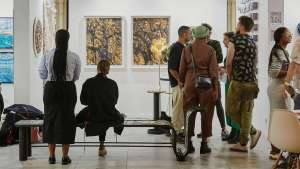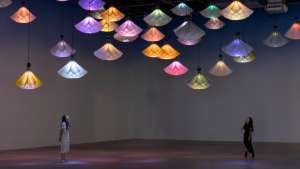In India, the supposed fading of Urdu is a hotly debated topic, while in other parts of the world it is still a flourishing language. But as globalisation wipes out most things people consider familiar and leaves them with inescapable bastardisations, what is the fate of Urdu?
Do not for a moment imagine that Urdu isn’t adapting. Type is being created for online usage. Calligraphers have left the sober confines of workshops to spill onto streets screaming anarchy on walls, all in this poetic old tongue.
To allow thought and creative interpretation, Design Fabric asked a few artists to predict the future of Urdu in 2050. Will the Jetsons spout Urdu poetry? Will young girls drop Rumi bombs on the 2050 version of social media to passive aggressively call out lousy lovers? Or will the language be forgotten until it is excavated by archeologists from 2050 in an old crushed newspaper along with a statue of Mayawati clutching her handbag?
Here are a few of their interpretations:
Ghar-e-beghar (Homeless in Homeland) - Furqan Jawed
Furqan assesses that Urdu is now associated with the rhetoric of a Muslim identity. And in the existing scenario this doesn’t bode well for the growth of the language either in India or abroad.
So, to restrict oneself to the aesthetic beauty of the language alone would be unfair, one must consider the socio-political scenario that has curbed the language and possibly points towards its demise. Hence the dystopian world and representation of a language that is struggling to survive despite the clichés and stereotypes that are thrust upon it.
Jahaan-E-Urdu- Mohammad Azad
Here the letter ‘U’ looms large and omniscient. Mohammad uses the U to amalgamate everything the language stands for in 2050. He sees a world where the culture of ‘tehzib’ still flourishes and Urdu draws strength from that.
It nurtures and protects the essence of other languages, as Sanskrit once was the root of everything, Urdu is now the root and the constant. It blends and seamlessly adapts into popular culture, as any language must do, to survive.
Anjaam (The Culmination)- Qamar Dagar
Qamar Dagar speaks of elegance and refinement, and how Urdu with its sweet rhythm and charm is perfect for poetry. Is this why there is such a ‘khazana’ of writings available from stalwart poets in Urdu? Of course.
But the language also draws you in with aesthetics; the delicate calligraphy and linear beauty of Urdu are quite unmatched. And yet Urdu adapts and grows and when you change the physicality of the written form, something changes internally.
It is a subtle change but a powerful one and if you notice, Urdu has now evolved from a language of communication into a visual art. Isn’t that true of the future as well? Dagar creates the visual of a flower blossoming, that blends the script into its form. A poetic metaphor for a language of poets.
Mustaqbil- Yusuf Zamani
Zamani sees the language from the eyes of an optimist. It adapts and moulds itself into the most popular mode of communication of the time. Be it digital code or advertising jargon, it lives and thrives by becoming available and useful.
This piece is part of a Design Indaba content partnership with Design Fabric in India.










